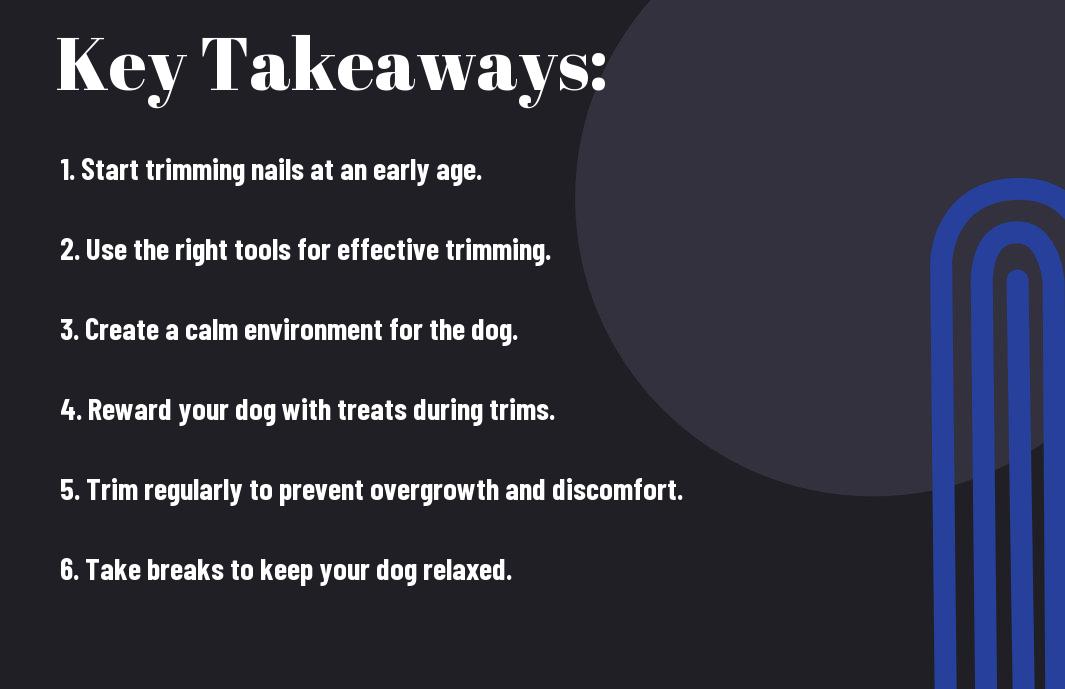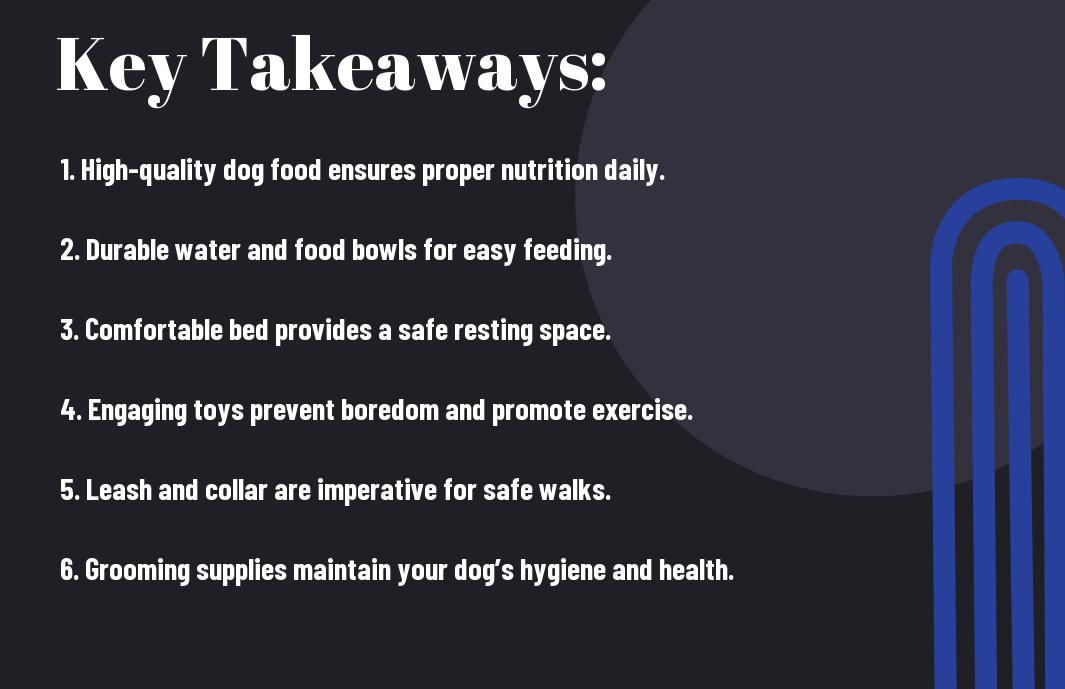There’s no need to dread dog nail trimming anymore! With the right techniques and a bit of preparation, you can make this necessary task easier for both you and your furry friend. In this post, you will discover valuable tips and tricks that will help you create a calm environment, reduce anxiety, and efficiently trim your dog’s nails without the struggle. Say goodbye to stressful nail trimming sessions and hello to a happier, more relaxed experience for you and your dog!


Understanding Dog Nail Anatomy
The Structure of Dog Nails
The anatomy of dog nails consists of several components that contribute to their overall health and function. Around the outer edge, you’ll find the hard, keratinized portion, which forms a protective shield that prevents damage to the sensitive tissues underneath. Inside this outer layer lies the nail bed, a soft tissue that contains blood vessels and nerves. It is important for you to recognize that the nail structure varies between breeds; for instance, some dogs have clear nails, making it easier for you to identify the quick, while others have dark nails, where it can be challenging to see this sensitive area.
The growth of your dog’s nails is influenced by various factors, including their age, lifestyle, and activity level. If your dog frequently walks or runs on hard surfaces, their nails may wear down naturally, while indoor dogs may need regular trimming to maintain a balanced nail length. Knowing your dog’s unique nail characteristics will help you develop a suitable nail care plan.
Importance of Regular Nail Trimming
Structure and function of your dog’s nails emphasize the importance of maintaining their length. Overgrown nails can lead to discomfort and pain, as they can curl or break, causing injury to the nail bed or paw. Additionally, long nails can alter your dog’s natural gait, leading to possible musculoskeletal issues. Regular trimming is imperative not just for aesthetic reasons, but also to ensure your dog’s comfort and physical health.
But beyond comfort, keeping your dog’s nails well-trimmed contributes to a more enjoyable bonding experience during grooming sessions. By establishing a routine that includes nail trimming, you can reduce anxiety for both you and your pet. It will also provide you with an opportunity to inspect your dog’s overall foot health, catching any potential issues early on. With consistent care, you create a positive environment where your dog feels secure and well looked after.
Preparing for Nail Trimming
It’s vital to prepare both you and your dog for a stress-free nail trimming experience. Taking the right steps before the actual trimming can make a significant difference in both your comfort levels and your dog’s receptiveness to the process. Start by ensuring that you have all the necessary tools and create a conducive environment that will ease any anxiety for both of you. This preparation will set the stage for a smooth and successful nail trimming session.
Choosing the Right Tools
At the heart of a successful nail trimming session is selecting the right tools. Invest in high-quality nail clippers specifically designed for dogs, as different breeds may require different styles, such as guillotine, scissor, or electric clippers. Make sure that the clippers are sharp and suited to the size of your dog’s nails; dull clippers can crush the nail rather than cutting it cleanly, causing pain and anxiety. Additionally, having a file or grinder on hand can help smooth the edges after trimming, allowing for a more polished finish without leaving sharp points that may snag on surfaces.
Creating a Calm Environment
The atmosphere surrounding your nail trimming session plays a significant role in how your dog will respond to the process. Choose a quiet space free from distractions where your dog feels comfortable. This could be a favorite spot at home or a secure area where they can relax. Additionally, using soothing music or calming pheromone diffusers can help to create a more serene atmosphere, potentially easing your dog’s anxiety.
Another important aspect of environment creation is ensuring that your dog is physically comfortable during the trimming. Use a non-slip surface to help prevent slips and slides, which can cause anxiety. Make certain that you and your dog are at a stable, comfortable height during the trimming process—this could mean sitting on the floor or using a raised area that allows you to maintain a gentle hold on your dog. A well-prepared environment is key to transitioning your dog into a positive and easy nail trimming routine.
Techniques for Stress-Free Trimming
Once again, navigating the dog nail trimming process can be simplified through effective techniques tailored to both you and your pet’s comfort levels. Employing proper methods not only makes the trimming go smoothly but can also transform the experience into a positive bonding activity. Some dogs may be more anxious than others, so it’s crucial to choose techniques that adapt to their individual personality and comfort zone.
Gradual Desensitization
Among the most effective techniques for reducing anxiety during nail trimming is gradual desensitization. This approach involves exposing your dog to the nail trimming process in small, non-threatening increments. Start by allowing your dog to explore the grooming area, the tools you will use, or even just the sound of nail clippers without any actual trimming happening. Provide treats and praise to create positive associations.
Eventually, you will introduce the clippers or grinder closer to their paws, again rewarding them for calm behavior. The key is to take each step slowly and ensure your dog is comfortable before progressing to the next phase. Patience is vital; this may take several sessions, but over time, your dog will become more accustomed to nail trimming, making the actual process much easier for both of you.
Step-by-Step Trimming Guide
Along with desensitization, following a step-by-step trimming guide can streamline the nail trimming process. With a structured approach, you can effectively manage your dog’s anxiety while ensuring their nails are trimmed safely and correctly. Below is an easy-to-follow guide that highlights each step necessary for a successful grooming session.
Step-by-Step Trimming Guide
| Step 1: Get Your Supplies | Gather clippers, treats, Styptic powder, and a comfortable place for your dog. |
| Step 2: Get Your Dog Comfortable | Familiarize your dog with the area and tools; reward them for calm behavior. |
| Step 3: Position Your Dog | Place your dog in a comfortable position, like sitting or lying down, where they feel secure. |
| Step 4: Start Slowly | Select one paw to begin with, gently hold it, and start with one nail. |
| Step 5: Clip and Reward | As you clip each nail, give praise and treats to reinforce a positive experience. |
| Step 6: Repeat as Needed | Allow breaks if needed and be patient; complete the full trimming over multiple sessions if necessary. |
At the end of each trimming session, it’s beneficial to provide additional praise and perhaps a favorite toy or extra cuddles. This reinforcement helps to build a positive association between nail trimming and enjoyable moments, encouraging your dog to remain calm for future grooming. As you become more familiar with your dog’s behavior, you’ll find ways to adapt the steps that work best for them, making each session progressively smoother.
Alternative Methods to Nail Trimming
Keep in mind that trimming your dog’s nails doesn’t always have to involve traditional clippers. Many owners find alternative methods to be more effective and less stressful for both themselves and their pets. These alternatives often include nail grinders, which can smooth and shape nails without the harsh cutting motion of clippers. While some dogs may prefer the comfort of grinding, others might feel uneasy. It’s vital to gauge your dog’s reaction and choose the method that best suits their personality and comfort level.
Nail Grinders vs. Clippers
Methods of nail trimming vary significantly with the tools you choose, particularly between grinders and clippers. Nail grinders, which use a sanding motion, tend to be quieter and less intimidating for many dogs. They also allow for more gradual shaping of the nail, reducing the risk of over-trimming. On the other hand, nail clippers can provide a quicker solution, especially for dogs that are particularly fidgety or stressed by the grinding motion. Finding a balance between these two tools can help you create a manageable grooming routine tailored specifically to your dog’s needs.
Professional Grooming Options
Any time you feel uncertain about trimming your dog’s nails or if your pet is particularly anxious, consider seeking professional grooming services. Professional groomers are trained to handle dogs of all temperaments and can take on the responsibilities of nail trimming with ease. They often have access to specialized tools and techniques that ensure a safe and efficient grooming experience, giving you peace of mind as a pet owner.
This option can also introduce your dog to socialization in a calm environment, potentially reducing fear and anxiety around nail trimming in the future. Additionally, visiting a professional can give you valuable insights into your dog’s nail care routine and keeps their paws healthy and well-maintained. Regular professional grooming can help instill a positive association with the grooming process, making future home sessions easier and more enjoyable for you and your pet.
Signs of Nail Trimming Anxiety
Many dog owners may overlook the signs of nail trimming anxiety in their pets, leading to a more stressful experience for both you and your furry friend. Your dog may not necessarily vocalize their discomfort, so it’s crucial to be aware of subtle changes in behavior that signal stress or fear during the grooming process. Recognizing these signs early will allow you to take proactive steps to create a more relaxed environment for nail trimming sessions.
Recognizing Stress Signals
One of the primary indicators of nail trimming anxiety is body language. Pay attention to signs such as flattened ears, tucked tails, or excessive licking. Your dog may also try to escape or hide when you bring out the nail clippers, indicating a fear of the process. Other stress signals include whining, barking, or a stiffened body posture. Being mindful of these reactions will help you gauge how your dog feels about nail trimming and guide you in adjusting your approach accordingly.
Tips to Reduce Fear and Anxiety
With some thoughtful strategies, you can alleviate your dog’s anxiety surrounding nail trimming. Begin by creating a positive association with nail clippers. Start by allowing your dog to sniff and explore the clippers during playtime, followed by rewarding them with treats and praise. You should also incorporate regular paw handling in your routine to get your dog comfortable with having their feet touched. Here are a few additional tips to foster a calming environment:
- Choose a quiet space without distractions for your dog.
- Utilize calming scents or pheromone sprays to create a soothing atmosphere.
- Keep grooming sessions short and rewarding, introducing nails gradually.
Perceiving these signs of fear and responding positively can drastically improve your dog’s comfort level.
Due to the innate differences in every dog, some may need more time to adjust to nail trimming than others. It’s worthwhile to progress at a pace that works for you and your dog. Incorporating positive reinforcement and gradual exposure not only builds trust but also helps to make nail trimming a routine part of your dog’s grooming process. Take advantage of tools like treats and engaging toys during nail sessions to reinforce calm behavior. Further tips to keep in mind include:
- Practice nail trimming on one paw at a time to reduce overwhelm.
- Try using a Dremel tool instead of clippers if your dog appears more anxious with traditional methods.
- Enlist the assistance of a friend or professional groomer if needed.
Perceiving your dog’s unique needs and adjusting accordingly will ultimately pave the way for a stress-free nail trimming experience.
Maintaining Nail Health Between Trims
Now that you have the basics of dog nail trimming down, it’s important to maintain nail health between trims. Keeping your dog’s nails in good condition not only makes the next trimming session easier but also contributes significantly to your pet’s overall well-being. Regular care and checks can help you identify any potential problems early, allowing you to address them before they become more serious issues.
Regular Checks and Care
The best way to ensure your dog’s nails remain healthy is by incorporating regular checks into your routine. Perform a quick inspection of your dog’s nails about once a week to monitor for any signs of splitting, cracking, or excessive wear. Paying attention to the surrounding paw pads and skin is also important, as any irritation can impact nail health. If you notice any abnormalities, such as discoloration or sensitivity, consult your veterinarian for advice on how to proceed.
Proper Diet for Nail Strength
Care also extends to your dog’s diet, which significantly influences the strength and health of their nails. Providing a balanced diet that incorporates crucial vitamins and minerals will promote not only strong nails but overall well-being. Foods rich in omega fatty acids, biotin, and zinc can contribute positively to nail strength and growth. Look for high-quality dog food that includes these nutrients, and consider discussing with your vet if additional supplements would benefit your pet.
Considering the overall nutritional needs of your dog, combining a diet rich in these key nutrients with regular nail maintenance can yield excellent results. Pay attention to how your dog’s nails react to dietary changes, as you may find that some foods or supplements work better than others for promoting nail health. By staying vigilant about their diet and incorporating regular checks, you can help maintain your dog’s nails in top condition until their next trim. This proactive approach will not only keep their nails healthy but also contribute to their happiness and comfort.
Final Words
Upon reflecting on the tips and techniques for stress-free dog nail trimming, you can see how a little preparation and understanding can make the process far more manageable. By familiarizing yourself with your dog’s behavior and building a positive experience surrounding nail trimming, you not only ensure your dog’s comfort but also build trust between you and your furry companion. Consider using treats and praise to create a relaxing environment, and take it slow—your patience will pay off in creating a smoother routine.
Your dedication to mastering these strategies will lead to a more enjoyable experience for both you and your dog. Regular nail maintenance doesn’t have to be a dreaded chore; with the right mindset and techniques, it can evolve into a simple, even bonding, activity. Keep practicing and soon you’ll find that nail trimming can become a regular part of your grooming routine that you both look forward to, ensuring your dog remains happy and healthy.










